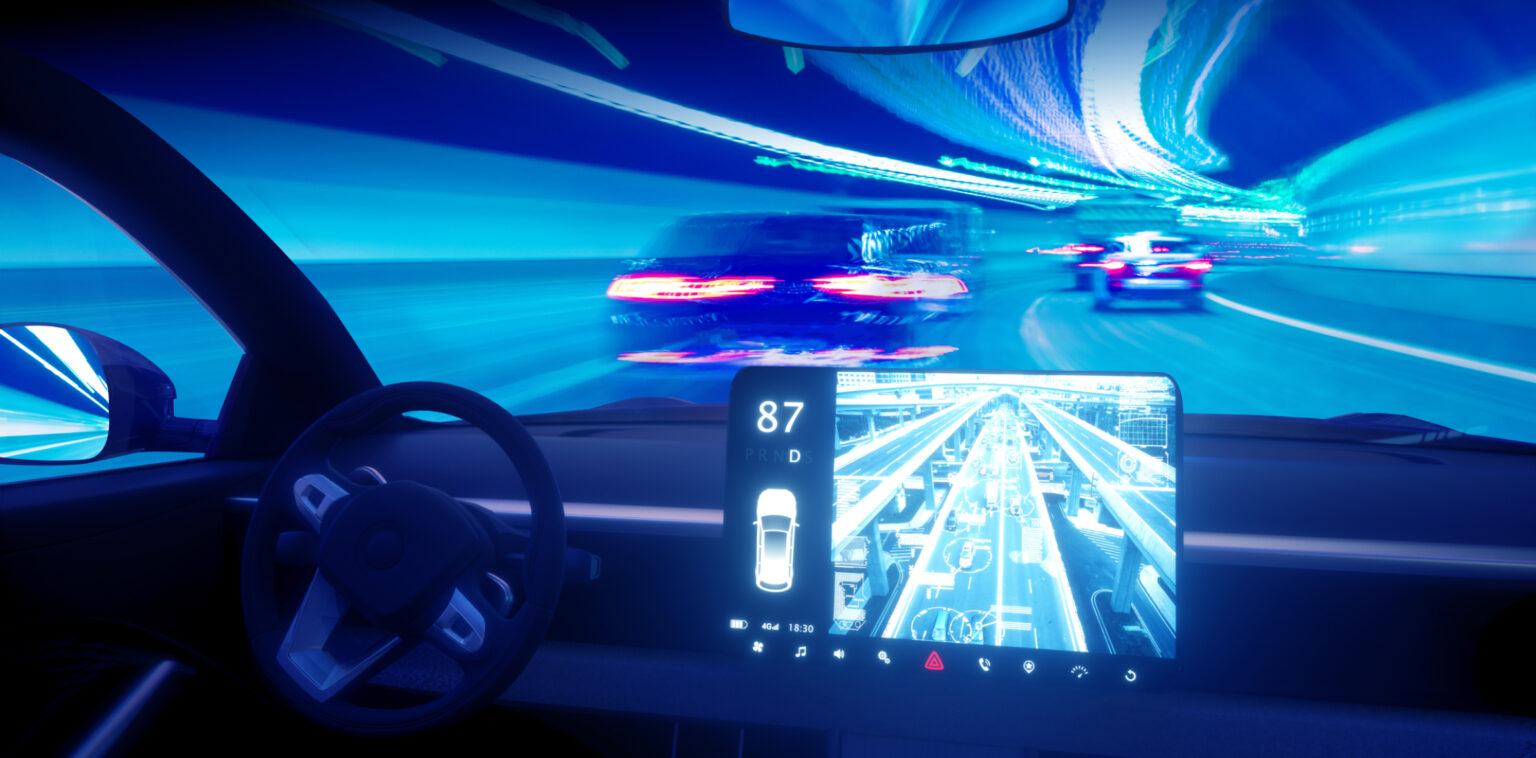Vehicle automation is a broad term that can spark dreams of a bright future. Before we get there, however, some definitions are needed to understand the market, know where it stands, and to innovate accordingly and confidently.
In this article:
- Vehicle Automation by the Numbers
- Automated Vehicle Spectrum (media)
- Vehicle Automation
- What the Industry is Working On: Key Areas of Development and Challenges
Consumers are often excited to hear their new car will come with “automated driving features”, picturing a highly efficient city where they can roam around in their car doing other tasks or entertaining themselves as they please.
However, the reality might not be there yet. That doesn’t mean that some levels of automation aren’t available today. In fact, this imaginative scenario might be closer than it seems, but to understand where we’re at, and where we’re trying to go, consumers and engineers needed a clearer framework of what they can expect when they hear the term “automated vehicles”.
For this reason, the Society of Automotive Engineers (SAE) came up with the 6 levels that comprehend automated driving to further define where a vehicle stands in the spectrum of automation and where innovations could go.
The six level spectrum ranges from 0 (no automation) to 5 (fully automated).
By the numbers:
- Sources forecast shipping of 8 million vehicles ranging from level 3 to 5 in 2025.
- As per Bloomberg’s article: “The Global Autonomous Vehicle Market is projected to grow at a CAGR of 37.61% from 2023 to 2030 , according to a new report published by Verified Market Research®. The report reveals that the market was valued at USD 91,671.67 Million in 2021 and is expected to reach USD 1,278,840.57 Million by the end of the forecast period.”
- LiDAR (Light Detection and Ranging) sensors could become the next step from ADAS with higher level of automation requirements.
- Over 35 million LiDAR units are forecasted to ship in 2025, translating to a market value of $7.2 billion.
Automated vehicle spectrum:

Level 0:
No automation: Human driver manually steers, accelerates, brakes, and executes all tasks that move the car in any direction.
However, technologies like collision warning, blind-spot indicators, stability control and even lane-keeping assistance or emergency braking can still fall under level 0 automation since these don’t drive the vehicle but provide alerts or momentary actions to respond to specific situations.
Level 1:
Driver assistance: The driver is assisted by a single automated system. Level 1 automation includes systems providing steering assistance or braking/acceleration assistance.
Adaptive cruise control or lane centering/following assistance are good examples of level 1 automation. However, the driver must complete other driving tasks, and remains responsible and ready to take control at all times.
The keyword here is or, as a vehicle presenting both features would fall under the level 2 of driving automation. Only one automated system is included in level 1 driving automation.
Level 2:
Partial automation: Advanced Driving Assistance Systems (ADAS) in this level can take over driving tasks like acceleration, braking, and steering in specific situations. The human driver, however, must remain active supervision of the vehicle and technology.
Automakers are currently offering cars at this level of automation. Some examples are:
- Highway Driving Assist systems:
- Active steering, acceleration and braking for vehicles traveling on highways.
- Requires drivers to keep their hands on the wheel at all times.
- Can be found on some Genesis, Hyundai and Kia vehicles.
- BlueCruise systems:
- New technology designed by Ford.
- Allows for hands-free driving on specifically approved highways available in the US and Canada.
- Tesla’s Full-Self Driving Autopilot
- Tesla currently offers various versions of autopilot including a Full-Self Driving mode, however the system still classifies as level 2, where the driver must remain in active monitoring mode and ready to take control as needed.
THIS POINT MARKS THE CURRENT STATE OF AUTOMATED DRIVING AVAILABLE TO THE PUBLIC. THE FOLLOWING LEVELS PRESENT THE LEAP BETWEEN WHAT’S IN THE MARKET NOW TO THE TECHNOLOGY BEING DEVELOPED NOW AND THE POSSIBILITIES OF TOMORROW.
Level 3:
Conditional Driving Automation: Adds several driving assistance systems and artificial intelligence to take virtually full control of the vehicle. This is the first level where the human in the driver’s seat is not actually driving. However, while this technology can go unsupervised by the people in the car, there must be a human driver present and ready to take control in case a feature requests it, there’s an emergency, or in the case of a system failure.
Some versions of this technology exist today, however none of them are legal for road use in America yet. Audi presented its first level 3 system in 2019, but it was never approved by the regulatory system in Germany. After this, Honda became the first automaker to actually sell an approved level 3 system in 2021, only available for use in Japan. Other automakers, such as Mercedes Benz, are currently equipping vehicles with their versions of level 3 autonomy but are still waiting for regulatory approvals.
Level 4:
High Driving Automation: This level of autonomous driving needs no human intervention at all since the systems are designed to stop automatically in case of any failure. At this level of automation, vehicles are bound to specific geographical areas by geofencing technology, making them able to travel from point A to point B without the need for a driver.
Level 4 driving automation opens endless possibilities for applications like driverless taxis and public transportation and could revolutionize vehicles as we know them.
The future of driverless cars may look more like capsules of comfort, convenience, or entertainment without even having the need for wheels or pedals.
Level 5:
Full driving automation: At level 5 of driving automation, vehicles can drive themselves anywhere, under any conditions without the need for human intervention other than setting a destination. This level of autonomy is no longer limited by geofencing nor harsh weather conditions, revolutionizing our concept of private and shared traveling.

What the industry is working on
While Level 3 automation is starting to take shape and solidifying, some companies are already working on doing the same for levels 4 and 5. These are some of the current areas of focus and key challenges to tackle.
Key areas of development
- Sensor technologies: LiDAR, cameras, radars, and ultrasonic sensors are the lifeblood of automated driving. Improvements in precision, accuracy and reliability of these sensors mean steps forward for vehicle automation.
- AI and Machine Learning: Improvements in AI and the collection and processing of vast amounts of data become vital for the decision-making capabilities of autonomous vehicles.
- High-definition mapping: Detailed, accurate and up-to-date maps are essential for automated vehicle navigation and route-planning. This is one of the reasons why some technologies may be approved only on certain highways in the world.
- Vehicle-to-vehicle (V2V) and Vehicle-to-Infrastructure (V2I) connectivity: Information and data sharing between vehicles and their surrounding infrastructure helps improve safety and efficiency in topics such as route planning and decision-making.
Current challenges to tackle
- Testing and validation: As is the case for all important innovations, but especially with a topic that could revolutionize mobility as we know it, testing and validation processes are extensive and exhaustive. Real world testing facilities are vital to the launch of new technologies in driving automation.
- Regulatory frameworks: Startups and established companies agreed on regulatory frameworks to be the major bottleneck in autonomous driving innovation. It’s important to actively collaborate with governments and regulatory bodies to establish standards and safety regulations to bring these innovations into reality.
- Partnerships and collaborations: Autonomous vehicles have brought a revolution not only to cars as we know them, but to mobility as a whole. This has brought together companies from different realms of expertise. For example, vehicles now need more software than ever before, so tech giants, automotive companies, and software startups need to collaborate to accelerate developments.
- Public acceptance and perception: Education about autonomous vehicle use and safety will become important for mass adoption in the market.
Thanks to the Society of Automotive Engineers six levels framework for vehicle automation, we can better understand what we are talking about when we talk about automated vehicles. While the current market is based on cars ranging from level 0 to 2, it wouldn’t be a surprise if we took a leap into the second half of the spectrum in the near future.
If and when we do… where will your innovations fit the puzzle?






